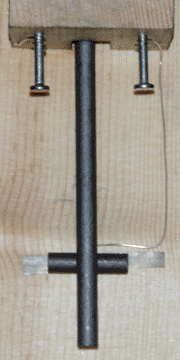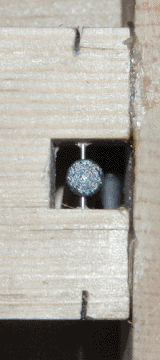



The carbon microphone is a very important piece of technology, which can convert sound to an electric signal using very common materials. It is also its own amplifier, in that the signal produced is many times more powerful than the sound that created it. Although currently obsolete, I believe this kind of microphone is an essential piece of equipment for anyone interested in experimenting with electronics at the most basic level.
The principle of operation is very simple. The microphone consists of a thin diaphragm of any stiff material, which will vibrate when struck by sound waves. This diaphragm is then mechanically coupled to one or more loose contacts between conductive materials. Carbon is most often used due to the fact that most metals will oxidize over time. As the vibrations pass through these contacts, the contacts are alternately compressed and expanded, which modulates their resistance. If the microphone is then connected to a battery, the current flow through the microphone will be modulated by sound.
In my case, the diaphragm is simply a piece of pine board, with a 3 by 3 inch section milled down to a thickness of 1/16th of an inch. The loose contact is made between two pieces of 1/4 inch graphite rod. One piece is attached to the back of the diaphragm board with double-sided tape, with a thin nickel wire compressed between the rod and the board. The other is hung near-vertically from a piece of thick nickel wire, so that the contact is very light. The nickel leads from each electrode are then wrapped around two nails, which form the terminals of the microphone.
The microphone operates surprisingly well. The sensitivity can be adjusted by tilting the microphone, which alters the pressure between the rods due to the effect of gravity. If the pressure is too light, the hanging rod will have a tendency to break contact, resulting in popping and distortion. If the pressure is too heavy, the sound will be clean but low in volume. It is not difficult to adjust though, and an ammeter can be used to find the point at which the microphone operates best. This microphone in particular seems to work well with about 80mA of current running through it from a single D cell. When speaking into the microphone, a whisper will modulate this current by about 5mA peak-to-peak; speaking normally will modulate it by about 10mA, and speaking loudly around 20mA. This indicates that the microphone is fairly efficient.
A demonstration of the performance of the microphone can be heard below. To record this, I connected the microphone and battery in series with an 5K:8 audio transformer, operating in reverse as a step-up transformer. The output was then connected to the line-in port on my computer. The microphone had to be tilted somewhat to reduce the volume; operating normally, this circuit would produce around 3V peak-to-peak from normal speech, which would be clipped by the sound card.
One final note is that this is by no means the only way to construct a microphone of this type. More rods could be used to increase the power output and reduce distortion, other conductive materials could be used for said rods, and many other materials could be used as a diaphragm (I have previously used thin plywood). The key is the loose contact, the rest is up to personal preference.